ACL800兆欧表中文说明书
- 格式:doc
- 大小:22.00 KB
- 文档页数:7
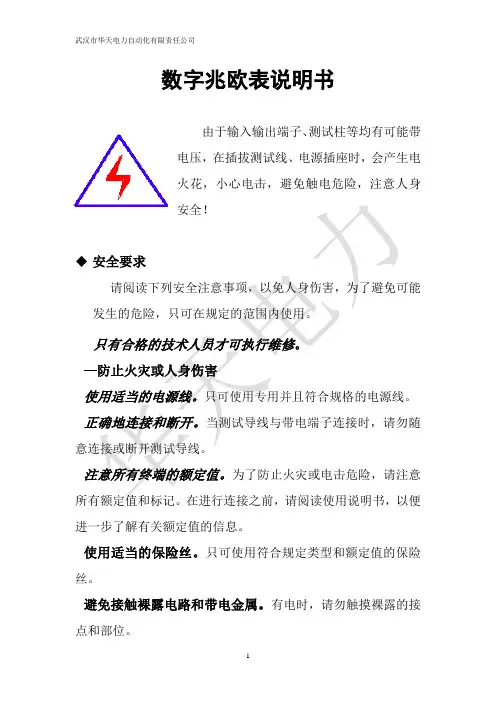
数字兆欧表说明书由于输入输出端子、测试柱等均有可能带电压,在插拔测试线、电源插座时,会产生电火花,小心电击,避免触电危险,注意人身安全!安全要求请阅读下列安全注意事项,以免人身伤害,为了避免可能发生的危险,只可在规定的范围内使用。
只有合格的技术人员才可执行维修。
—防止火灾或人身伤害使用适当的电源线。
只可使用专用并且符合规格的电源线。
正确地连接和断开。
当测试导线与带电端子连接时,请勿随意连接或断开测试导线。
注意所有终端的额定值。
为了防止火灾或电击危险,请注意所有额定值和标记。
在进行连接之前,请阅读使用说明书,以便进一步了解有关额定值的信息。
使用适当的保险丝。
只可使用符合规定类型和额定值的保险丝。
避免接触裸露电路和带电金属。
有电时,请勿触摸裸露的接点和部位。
请勿在潮湿环境下操作。
请勿在易爆环境中操作。
-安全术语警告:警告字句指出可能造成人身伤亡的状况或做法。
目录第一章概述 (5)第二章介绍 (5)一、特性 (5)二、技术指标 (6)三、仪表结构 (7)四、仪表原理 (8)第三章使用方法 (9)一、准备工作 (9)二、开始测试 (10)三、屏蔽端使用方法 (11)四、电池充电 (12)第一章概述随着我国电力工业的快速发展,电气设备预防性实验是保障电力系统安全运行和维护工作中的一个重要环节。
绝缘诊断是检测电气设备绝缘缺陷或故障的重要手段。
绝缘电阻测试仪(兆欧表)是测量绝缘电阻的专用仪表。
1990年5月批准实施的JJG662-89《绝缘电阻表(兆欧表)》已把它作为强制检定的仪表之一。
目前,电气设备(如变压器、发电机等)朝着大容量化、高电压化、结构多样化及密封化的趋势发展。
这就需要绝缘电阻测试仪本身具有容量大、抗干扰能力强、测量指标多样化、测量结果准确、测量过程简单并迅速、便于携带等特点。
HT2500系列绝缘电阻测试仪采用超薄形张丝表头、多种电压等级输出、容量大、抗干扰强、交直流两用、操作简单、具有时间提示功能。

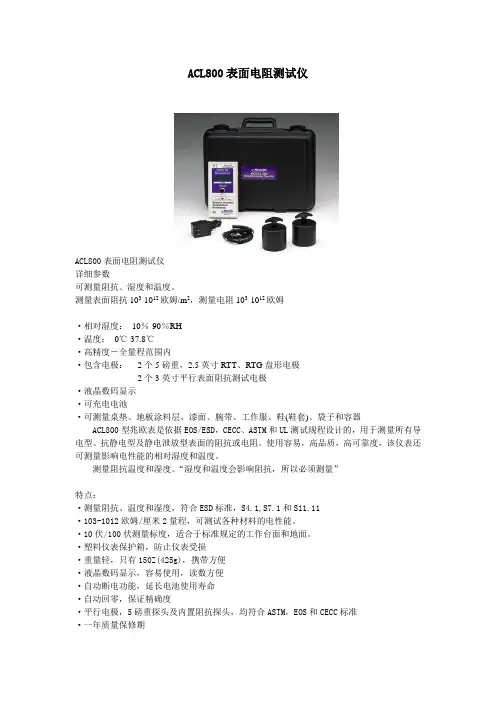
ACL800表面电阻测试仪ACL800表面电阻测试仪详细参数可测量阻抗、湿度和温度。
测量表面阻抗103-1012欧姆/m2,测量电阻103-1012欧姆·相对湿度:10%-90%RH·温度:0℃-37.8℃·高精度-全量程范围内·包含电极:--2个5磅重,2.5英寸RTT、RTG盘形电极--2个3英寸平行表面阻抗测试电极·液晶数码显示·可充电电池·可测量桌垫、地板涂料层、漆面、腕带、工作服、鞋(鞋套)、袋子和容器ACL800型兆欧表是依据EOS/ESD,CECC、ASTM和UL测试规程设计的,用于测量所有导电型、抗静电型及静电泄放型表面的阻抗或电阻。
使用容易,高品质,高可靠度,该仪表还可测量影响电性能的相对湿度和温度。
测量阻抗温度和湿度。
“湿度和温度会影响阻抗,所以必须测量”特点:·测量阻抗、温度和湿度,符合ESD标准,S4.1,S7.1和S11.11·103-1012欧姆/厘米2量程,可测试各种材料的电性能。
·10伏/100伏测量标度,适合于标准规定的工作台面和地面。
·塑料仪表保护箱,防止仪表受损·重量轻,只有150Z(425g),携带方便·液晶数码显示,容易使用,读数方便·自动断电功能,延长电池使用寿命·自动回零,保证精确度·平行电极,5磅重探头及内置阻抗探头,均符合ASTM,EOS和CECC标准·一年质量保修期·美国制造,信心、质量、服务的保证·NIST追踪,ISO9000保证·可替换探头,延长使用寿命·9V直流电或镍镉充电电池或交流变压器,在美国及海外均通用。
ACL800型兆欧表世界上最好的阻抗表,集阻抗、湿度、温度三种测量仪表于一体。
型号 ACL800表面阻抗 103-1012Ω/cm2电阻 103-1012Ω湿度 10%-90%RH温度 32℉ -100℉(0℃-37.8℃)电压 10v/100v电源 9V标准电池配置:仪器,两个重锤,两条重锤连接线,一条接地线,9V电池,万用充电器一个,工具箱,说明书,校正证书ACL800兆欧表操作手册测量前,首先确保待测表面干净无污染。
![3.3.2 摇表(兆欧表)_实用电工作业操作手册_[共3页]](https://uimg.taocdn.com/9322df9de45c3b3566ec8b21.webp)
实用电工作业操作手册压的大小,首先将表笔插在相应的插孔上,然后将两只表笔分别同时触及被测点,表盘读数即为被测两点的电压值。
(4)正确读数:钳流表刻度盘上有红、黑两条刻度线。
红色刻度线为电压刻度线,供测量电压时读数用;黑色刻度线为电流刻度线,供测量电流时读数用。
实际测量值应是指针指示值与量程开关倍率的乘积。
例如,若指针指示值为150A(表盘刻度值为0~300A),量程开关若分别位于30A、300A和3 000A时,则实际电流值分别为15A、150A和1 500A。
(5)注意安全:在测量过程中严禁转换量程挡。
因其钳形铁芯互感器是一个电流互感器,它的二次匝数很多,转换时相当于二次开路,将感应出很高的电压,可能会将绝缘击穿,造成仪表损坏和人身触电事故。
测量完毕应将钳流表的钳口松开,慢慢取出电线,并注意将其量程开关拨在最高电流挡或电压挡位置,以防下次使用时因粗心未选用合适的量程,致使表针打弯或造成其他事故。
另外,在潮湿和雷雨天气,为保证安全禁止在室外用钳形电流表测量。
2.钳形漏电流表钳形漏电流表是近几年推出的一种新型交流电流测试仪表,外形与普通的钳形电流表相似,实际上是一种高灵敏度的电流互感器。
钳形漏电流表一般既可以测量低压漏电流的大小,又可以测出漏电流中的有功分量及绝缘电阻的值。
测量运行中的用电器或电线的漏电流时,应将火线与零线2根电线(指单相交流电器)或将3根火线(指三相交流电器)一块卡在钳形漏电流表内,这是其与普通钳形电流表的最大区别。
目前,共立仪器公司(KYORITSU)生产的钳形漏电流表漏电流可测到4mA,工作电流可测到1 000A,兼有普通钳流表的功能,可供选择。
3.3.2摇表(兆欧表)摇表因其刻度盘读数为兆欧,故又称兆欧表,是一种测量电气设备绝缘电阻的仪表。
兆欧表有指针式和数字式两种,常见外形如图3-9— 118 —。
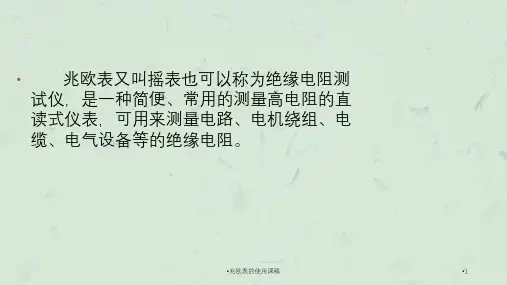

兆欧表使用说明绝缘电阻表又称兆欧表或摇表,用于测量各种电机,电缆,变压器原器件,家用电器和其它电器设备的绝缘电阻值。
1安全上的警告1.1本操作使用说明包含了警告讯息及安全规定,当使用本机时请确实遵守,以确保使用者的操作安全及仪器安全,因此于使用本机前请先仔细地彻底的阅读本说明。
1.2绝缘测试是用来测试已断电的电路(死线)或装置,请不要在有电的情况下(活线)做测试。
1.3在每次测试时请切记待测电路或装置必须是不带电的,请确认您可以清楚的看到待测电路或装置已与电力系统切离,在作绝缘测试前,在尚未确认是否带电时请勿做任何测试。
1.4如果您不知道如何开始特高阻测试(高压)请先与待测设备的制造商讨论,有些设备装置了高敏度的电子元件,可能在高直流的电压下造成损坏,原制造商可事先对此提出警告避免此种损坏。
1.5本测试器能产生10KV的直流高电压,于测试时请不要接触测试导线或被测设备,请不要尝试用本机器去刺激或惊吓别人。
潮湿的环境,流水的水笼都有可能造成触电而导致心脏停止。
1.6请时常注意您的仪器,测试导线以及其它附件是否有损坏的痕迹或变形,如果有任何异常发生(如:导线破损、机关壳裂缝,等),请不要进行任何测试。
1.7在做测试的过程中请注意不要让自己成为接地的通路,不要接触外露的金属管,出水口、固定物等,它们可能会让您成为接地电位。
另外请将您的身体与大地隔绝,例如使用干布、绝缘鞋、绝缘毯或其它保证绝缘的物质。
1.8为避免触电事故,在工作电压高于40VDC或20V AC时请使用警告标志。
1.9为避免触电事故,于测试中请勿触摸任何裸露的线或电路接点或被测物,即使已完成测试,在尚未确认放电安全前,也请勿触摸,是否已放电完成,可由数位的电压读值确认。
1.10请勿在易爆的大气中使用本机(如:可燃性气体、挥发液体及粉尘)1.11请不要尝试自行校正或维修本机,除非有经过训练的人员在场指导,或直接交由具有资格或受过训练的工程师处理。
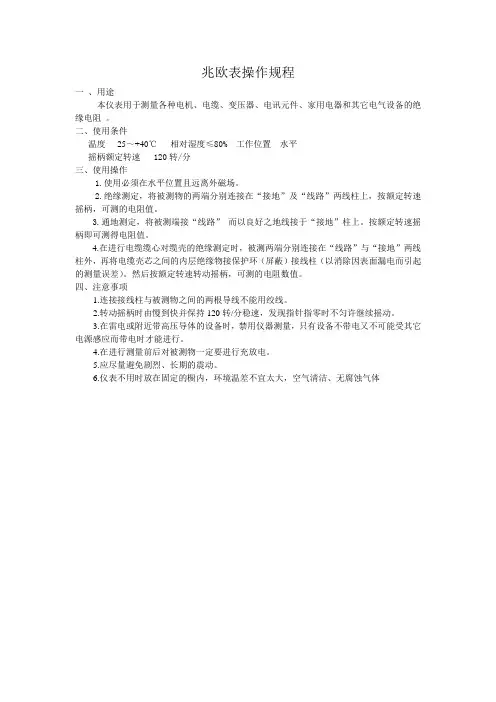
兆欧表操作规程
一、用途
本仪表用于测量各种电机、电缆、变压器、电讯元件、家用电器和其它电气设备的绝缘电阻。
二、使用条件
温度-25~+40℃相对湿度≤80% 工作位置水平
摇柄额定转速 120转/分
三、使用操作
1.使用必须在水平位置且远离外磁场。
2.绝缘测定,将被测物的两端分别连接在“接地”及“线路”两线柱上,按额定转速摇柄,可测的电阻值。
3.通地测定,将被测端接“线路”而以良好之地线接于“接地”柱上。
按额定转速摇柄即可测得电阻值。
4.在进行电缆缆心对缆壳的绝缘测定时,被测两端分别连接在“线路”与“接地”两线柱外,再将电缆壳芯之间的内层绝缘物接保护环(屏蔽)接线柱(以消除因表面漏电而引起的测量误差)。
然后按额定转速转动摇柄,可测的电阻数值。
四、注意事项
1.连接接线柱与被测物之间的两根导线不能用绞线。
2.转动摇柄时由慢到快并保持120转/分稳速,发现指针指零时不匀许继续摇动。
3.在雷电或附近带高压导体的设备时,禁用仪器测量,只有设备不带电又不可能受其它电源感应而带电时才能进行。
4.在进行测量前后对被测物一定要进行充放电。
5.应尽量避免剧烈、长期的震动。
6.仪表不用时放在固定的橱内,环境温差不宜太大,空气清洁、无腐蚀气体。
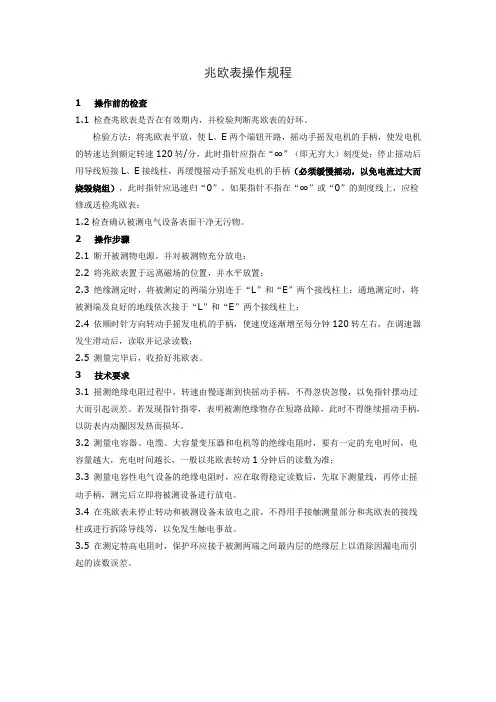
兆欧表操作规程1 操作前的检查1.1 检查兆欧表是否在有效期内,并检验判断兆欧表的好坏。
检验方法:将兆欧表平放,使L、E两个端钮开路,摇动手摇发电机的手柄,使发电机的转速达到额定转速120转/分,此时指针应指在“∞”(即无穷大)刻度处;停止摇动后用导线短接L、E接线柱,再缓慢摇动手摇发电机的手柄(必须缓慢摇动,以免电流过大而烧毁绕组),此时指针应迅速归“0”。
如果指针不指在“∞”或“0”的刻度线上,应检修或送检兆欧表;1.2检查确认被测电气设备表面干净无污物。
2 操作步骤2.1 断开被测物电源,并对被测物充分放电;2.2 将兆欧表置于远离磁场的位置,并水平放置;2.3 绝缘测定时,将被测定的两端分别连于“L”和“E”两个接线柱上;通地测定时,将被测端及良好的地线依次接于“L”和“E”两个接线柱上;2.4 依顺时针方向转动手摇发电机的手柄,使速度逐渐增至每分钟120转左右,在调速器发生滑动后,读取并记录读数;2.5 测量完毕后,收拾好兆欧表。
3 技术要求3.1 摇测绝缘电阻过程中,转速由慢逐渐到快摇动手柄,不得忽快忽慢,以免指针摆动过大而引起误差。
若发现指针指零,表明被测绝缘物存在短路故障,此时不得继续摇动手柄,以防表内动圈因发热而损坏。
3.2 测量电容器、电缆、大容量变压器和电机等的绝缘电阻时,要有一定的充电时间,电容量越大,充电时间越长,一般以兆欧表转动1分钟后的读数为准;3.3 测量电容性电气设备的绝缘电阻时,应在取得稳定读数后,先取下测量线,再停止摇动手柄,测完后立即将被测设备进行放电。
3.4 在兆欧表未停止转动和被测设备未放电之前,不得用手接触测量部分和兆欧表的接线柱或进行拆除导线等,以免发生触电事故。
3.5 在测定特高电阻时,保护环应接于被测两端之间最内层的绝缘层上以消除因漏电而引起的读数误差。
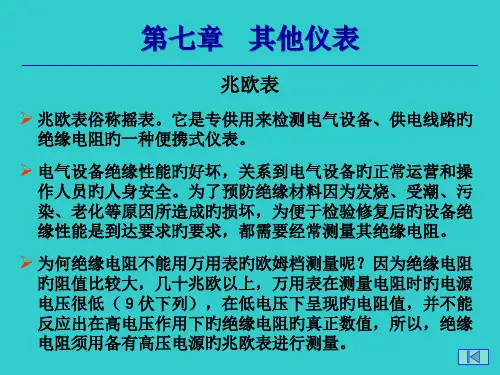


兆欧表实用操作手册兆欧表俗称摇表,它的刻度是以兆欧(MΩ)为单位的。
它是电工常用的一种测量仪表,主要用来检查电气设备、家用电器或电气线路对地及相间的绝缘电阻,以保证这些设备、电器和线路工作在正常状态,避免发生触电伤亡及设备损坏等事故。
数字兆欧表工作原理为由机内电池作为电源经DC/DC变换产生的直流高压由E极出经被测试品到达L极,从而产生一个从E到L极的电流,经过I/V变换经除法器完成运算直接将被测的绝缘电阻值由LCD 显示出来。
一、使用前准备第一步:检查兆欧表是否能正常工作,将兆欧表水平放置。
第二步:空摇兆欧表手柄,指针应该指到无穷大(最左边)处。
第三步:使L 和E 两接线桩输出线瞬时短接,再慢慢摇动手柄,指针应迅速指零(最右边)。
操作步骤:1、首先选用与被测元件电压等级相适应的摇表,对于500V及以下的线路或电气设备,应使用500V或1000V的摇表。
对于500V以上的线路或电气设备,应使用1000V或2500V的摇表。
2、用摇表测试高压设备的绝缘时,应由两人进行。
3、测量前必须将被测线路或电气设备的电源全部断开,即不允许带电测绝缘电阻。
并且要查明线路或电气设备上无人工作后方可进行。
4、摇表使用的表线必须是绝缘线,且不宜采用双股绞合绝缘线,其表线的端部应有绝缘护套;摇表的线路端子“L”应接设备的被测相,接地端子“E”应接设备外壳及设备的非被测相,屏蔽端子“G”应接到保护环或电缆绝缘护层上,以减小绝缘表面泄漏电流对测量造成的误差。
5‘’测量前应对摇表进行开路校检。
摇表“L”端与“E”端空载时摇动摇表,其指针应指向“∞”;摇表“L”端与“E”端短接时,摇动摇表其指针应指向“0”。
说明摇表功能良好,可以使用。
6、测试前必须将被试线路或电气设备接地放电。
测试线路时,必须取得对方允许后方可进行。
7、测量时,摇动摇表手柄的速度要均匀120r/min为宜;保持稳定转速1min后,取读数,以便躲开吸收电流的影响。
ACL800兆欧表中文说明书ACL800测量阻抗温度和湿度。
“湿度和温度会影响阻抗,所以必须测量”测量表面阻抗103-1012欧姆,测量电阻103-1012欧姆·相对湿度: 10%-90%RH·温度: 32。
F-100。
F(0℃℃)·高精度-全量程范围内ACL800详细介绍ACL800测量阻抗温度和湿度。
“湿度和温度会影响阻抗,所以必须测量”测量表面阻抗103-1012欧姆/□,测量电阻103-1012欧姆·相对湿度: 10%-90%RH·温度: 32。
F-100。
F(0℃℃)·高精度-全量程范围内·包含电极:--2个5磅重,英寸RTT、RTG盘形电极--2个3英寸平行表面阻抗测试电极·液晶数码显示PP9V电池·可测量桌垫、地板涂料层、漆面、腕带、工作服、鞋(鞋套)、袋子和容器ACL800型兆欧表是依据EOS/ESD,CECC、ASTM和UL测试规程设计的,用于测量所有导电型、抗静电型及静电泄放型表面的阻抗或电阻。
使用容易,高品质,高可靠度,该仪表还可测量影响电性能的相对湿度和温度。
特点:·测量阻抗、温度和湿度,符合ESD标准,,和·103-1012欧姆/□量程,可测试各种材料的电性能。
·10伏/100伏测量标度,适合于标准规定的工作台面和地面。
·塑料仪表保护箱,防止仪表受损·重量轻,只有150Z(425g),携带方便·液晶数码显示,容易使用,读数方便·自动断电功能,延长电池使用寿命·自动回零,保证精确度·平行电极,5磅重探头及内置阻抗探头,均符合ASTM,EOS和CECC标准·一年质量保修期·美国制造,信心、质量、服务的保证·NIST追踪,ISO9000保证·可替换探头,延长使用寿命·9V直流电或PP碱性电池或交流变压器,在美国及海外均通用。
ACL 800 MEGOHMMETEROPERATION MANUALNOTE: THIS MANUAL IS NOT TO BE SEPARATED FROM METER!ACL 800 MegohmmeterThe ACL 800 Megohmmeter kit measures surface resistivity, resistance, temperature and humidity. It is designed to test conductive, anti‐static, and static dissipative surfaces for electrical resistivity/resistance according to EOS/ESD, CECC, ANSI, ASTM and UL test procedures.The internal parallel electrodes comply with DIN EN 100 015/1 & ANSI/ESDA‐S11.11. The five pound electrodes can be externally connected for tests according to IEC 61340‐4‐1, ANSI/ESDA S4.1 & ANSI/ESDA S7.1.ACL 800 Megohmmeter Includes:TesterTwo 5lb probesOne ground cordTwo accordion cables (stereo to banana)110 power adapter*9 volt batteryFoam lined carrying caseCertificate of calibration*ACL 800 Celsius models come equipped with 220v power adapter unless specifiedACL 800 Optional AccessoriesConcentric Ring ProbeMiniature Ring ProbesGarment Clips for smocksLimitsResistivity: 103 ‐1012 ohms/sq.Resistance: 103 ‐1012 ohmsRelative Humidity: 10% ‐ 90% RHTemperature: 32°F to 100°F or 0°C – 37.7°C if Celsius model was purchasedMeasuring voltage: 10v and 100vI NTRODUCTIONThe ACL 800 Megohmmeter is a dependable and easy to use audit kit for conductive and dissipative surfaces. This meter is designed to be used in all facets of material production including engineering, maintenance, quality control, incoming inspection, manufacturing, research, or sales departments for the testing of anti‐static mats, floor finishes, paints, wrist straps, smocks, foot wear, bags and containers.When using the built‐in electrodes, the meter’s test values for surface resistivity are in ohms per square. When using the external five pound electrodes, the meter’s test values for resistance are in ohms (although they are displayed in ohms/sq.).D ECADE S CALE103 = 1 kilohm104 = 10 kilohms105 = 100 kilohms106 = 1 meg ohm107 = 10 meg ohms108 = 100 meg ohms109 = 1000 meg ohms1010 = 10,000 meg ohms1011 = 100,000 meg ohms1012 = 1,000,000 meg ohmsThe test value is indicated on the LCD display. Unlike meters with LEDS that indicate only the decade the measured value falls within, the ACL 800 will show the actual value.27 ohms (2.7 x 107) is displayed as 2.7 e07 ohms/sqT EST V OLTAGEThe test voltage ranges are 10v and 100v. According to ESDA standards S4.1, S7.1, and S11.11 one should choose 10v for conductive surfaces less than 106 and 100v for materials 106 or greater. . If the meter cannot apply the correct voltage automatically, it will advise you to change to the proper setting manually. Use the switch in front of the meter to change voltage setting.As defined by the ESD Association, values indicate the following:Voltage Range Definition 10 volt < 106 ohms per square Conductive 100 volt 106 – 1011 ohms per square Dissipative 100 volt 1012 > ohms per square InsulativeA NOTE ABOUT VOLTAGEIn previous years, people desiring to measure resistivity or resistance followed the ASTM D264, ASTM 991, NFPA 56A or NFPA 99 test standards. These procedures required people to test at either 500 or 1000 volts. This caused concern regarding safety to the person doing the tests. The ESDA standardized the test procedures so that lower volts could be used at specific ranges.The ACL 800 meter uses a 9 volt battery. Some meters with 9 volts batteries do not give the accuracy that you need to perform the tests especially at values higher than 107. The ACL 800 is built with a transformer that converts the 9 volt charge from the battery to 10 volts or 100 volts (whichever value is selected). The meter applies a constant charge over the complete voltage range. Accuracy is depends on applied voltage, temperature, and humidity.T EMPERATURE AND H UMIDITYThe humidity and temperature affect the electrical properties of the material being tested. The combination of low humidity and low temperature will give the highest electrical resistance results or slowest dissipation times. At high humidity a thin layer of water is condensed or absorbed on or in the material being tested. This is true of hydroscopic additives that are added to a material to increase the electrical conductivity. These additives will allow moisture to be absorbable in the materials they are added to.At elevated temperatures the mobility of free electrons is increased thereby increasing the materials conductivity. This is especially true for carbon black, metallic oxides, metals, and other materials added to a material. When the material is at a lower temperature, built in stresses occur which might increase the resistance due to increased distance between the conductive additives. Thus, humidity and temperature must be known.R ECORDING DATAANSI/ESD Association and European CECC recognize the environmental effects to test measurements and specify in their standards that they measured and recorded. It is possible to test or manufacture a material at high humidity and pass all the test specifications, but when the customer receives the material and uses it at a lower humidity or temperature the material fails to pass the specifications. This can cause rejects and loss of product.Both ESD S4.1 ESD Protective Worksurfacesection 6.2.4 and ESD S7.1‐1994 Resistive Characterization of Materials Floor Materials sections 5.2.4 and 5.3.3 require reporting of temperature and humidity at the time of testing.ANSI/EOS/ESD‐S11.11‐1993 Surface resistance measurement of Static Dissipative Planar Materials section 11.0 B states, “report the conditioning period, relative humidity, and temperature.”C ALIBRATIONCalibration is recommended annually. The ACL 800 meter comes with a NIST certificate when ordered. After one year the meters can be sent back to ACL Inc. for a new NIST certificate for a lab fee or it can be sent to a certified calibration lab (See page 11 for instructions). The meters also come with a CE mark approval.M EASURING WITH I NTERNAL E LECTRODESThe parallel resistivity probe method, complies with EOS/ESD‐S11.11. It is used to give fast electrical resistivity measurements on flat homogeneous materials. It may be used on multilayered materials, but this should be noted along with the temperature and humidity value on the data report.When the measurement is taken between the tester’s two conductive rubber rails under the tester, the tester will indicate the surface resistivity of the material being tested.A.Prior to testing, make certain that surfaces to be tested are clean and free ofcontaminants.B.Allow the meter to equilibrate to the atmosphere the meter is to be used in. It may takea half hour for the meter to adjust to new environment conditions.C.Place the meter on the desired surface to be tested.D.Move switch to desired test voltage position, either 10 or 100 volts, depending on thetarget range of the material.E.Press and hold the test button with approximately 5 pounds of applied force. Thedisplay will show the humidity and temperature. After approximately 10 seconds, themeter will display the surface resistivity in ohms per square.The meter will keep updating the display while the button is held down. The last reading will display for approximately 20 seconds after the button is released.M EASURING WITH E XTERNAL E LECTRODESWhen the measurement is taken using the 5lb external probes, the tester will indicate the resistance of the material being tested once the button is depressed (value is in ohms, though the display says ohms/sq).By utilizing these probes to the ACL 800’s sockets it is possible to measure Point to Point (RTT) Resistance, Surface to Ground (RTG), and Volume Resistance. Using these probes will allow compliancy with various standards including ANSI/ESDA S4.1 for Worksurface – Resistance Measurements, ANSI/ESDA S7.1 Resistive Characterization of Materials – Floor Materials.When auditing is finished, unplug the cables and store probes in the protective case. If cables are left in the tester, the jacks will lose their elasticity as shown below:If jacks are damaged or left in the open position, the internal probes will not engage whentesting for surface resistivity.Resistance Between Two Points (RTT)RTT measurements can be used for the evaluation of floors, chairs, carts, work surfaces and other ESD controlled materials and products. Procedures vary regarding sample preparation, probe preparation and spacing of the 5 pound probes. Select and read the correct testprocedure or standard for the desired measurement. Test procedures can be purchased from .A. Connect one end of each of the banana test leads into the sockets of the meter.Connect the other end of the test coil cords into the 5 pound probes.A. Place both probes on the material according to test procedures or standard being used.B.Press the “TEST” button and the value will be displayed on the LCD. The meter will applythe correct voltage (10v or 100v) according to the value of what is measured.C.When performing test do not touch lead wires or probe. Avoid overlapping of leadwires. This will ensure accurate readings.A N EXAMPLE OF MEASURING RTT ON DISSIPATIVE FLOORING:Taking routine measurements of tiles with dissipative floor finish will insure proper maintenance routines and will indicate any problems that may arise. Keeping a record of test results for temperature, humidity and electrical properties will provide a reference and will point toward a blueprint of traffic patterns on the floor. Good record keeping will insure success when developing and maintaining a maintenance program.To get an average measurement of a floor, map out a 4’ x 4’ section and conduct five tests (one at a time) within the square. Conduct a test for each side of the square and a final test diagonally through the center as shown in the drawing below.Each RTT test utilizes the 5 pound probes placed 3 feet apart (36 inches). Connect the test leads to the meter. Attach a 5 pound probe to the end of each lead and place 3 feet apart as indicated above. Press and hold the “TEST” button on the ACL 800 meter until a value is displayed.4’ x 4’ Section(not to scale)M EASURING R ESISTANCE TO G ROUND (RTG)Resistance to ground measurements can be used for the evaluation of floors, chairs, carts, work surfaces and other ESD controlled materials and products. Keeping a record of test results for temperature, humidity and electrical properties will provide a reference.A N EXAMPLE OF MEASURING RTG ON DISSIPATIVE FLOORING :For Testing Resistance on Floors, S7.1 requires a minimum of 5 RTG tests per 5,000 SqFt. Connect the leads for the external electrodes to the meter.Attach one lead to a 5 lb probe and place probe on the floor that’s being tested.Attach the other lead to an alligator clip and connect to a groundable point (RTGP). If using a ground adapter plug, plug the banana lead into the adaptor after the adapter is plugged into the receptacle.5 lb weight sits on the floorPush button for valuesA N EXAMPLE OF MEASURING RTG ON DISSIPATIVE T ABLE MATS:A.To test RTG for a workstation, connect the first lead to the meter and to a 5 lb probe andput probe on work surface. Connect the 2nd lead to the meter and to a groundable point (RTGP). Use the alligator clip if necessary.B.Press the “TEST” button and the value will be displayed on the LED. When performing testdo not touch lead wires or probe. Avoid overlapping of lead wires. This will ensure accurate readings.C.Resistance values are in ohms. Record temperature, humidity and resistance.If the range of your work surface is 106 to 109, measure at 100v. The EOS standard says the dissipative range is 106 – 1011 but most people look for 106 – 109 for a pass.Clip alligatorAttach the alligator clip to the lead and connect it to the ground snap or connect the banana plug to a common point ground plug:Volume Resistance Measurement M EASURING R ESISTANCE TO G ROUND (RTG)Volume Resistance measures the electrical path through a material.A. Connect one end of each of the banana test leads into the sockets of the meter.Connect the other end of the test coil cords into the 5 pound probes.B. Place sample material on a conductive metal plate (such as stainless steel). Place one ofthe 5 pound probes on the material so that the material is sandwiched between theprobe and metal plate. (see below)C. Place the second 5 pound probe on the conductive metal plate.D.Press the “TEST” button and the value will be displayed on the LED. Volume Resistanceis in ohms‐cm.ACL 800 C ALIBRATION I NSTRUCTIONSThe ACL 800 meter is calibrated to be most accurate in the most widely used range (106 ‐108). The lab calibrates meters between 30 ‐ 40% RH at 65 ‐ 73°F. If you are using the meter in atmospheres different than above, it is strongly advised to recalibrate the meter to your conditions.1. Purchase 1% 103‐1012 ohm resistors, high accuracy relative humidity hygrometer, andhigh accuracy thermometer.2. Open meter being careful not to disturb or break the two wires connecting the powerbutton to the circuit board.3. Observe on the right lower side of the meter printed circuit board three (3) calibrationpots.4. ALLOW THE METER TO EQUILIBRATE AND NORMALIZE IN THE ENVIRONMENT FOR 2HOURS BEFORE TESTING.5. Using the supplied coil cords attach alligator clips to the banana plug ends of the cords.6. Insert the 3.5mm ends into the meter jacks.7. Attach the ends of the resistors to the ends of the alligator clips.8. The top one is for humidity. The middle one is for resistivity. The bottom one is fortemperature. Adjustment is done with a small screw driver. Clockwise is to increase the value, counter clockwise to decrease the value.9. Press the power button and compare the resistor value, humidity, and temperature tothe parameter to be calibrated.10. Release the power button and slowly turn the correct adjustment pot.11. Re‐press the power button, and observe the LCD screen.12. Re‐press and adjust the pot if necessary.13. Close case and tighten the 4 screws.14. Press the power button to verify that the meter is working.***Should calibration traceable to the NIST be required, please call ACL, Inc. directly to arrange for calibration.SpecificationsAccuracy for 10‐volt scale:103 –104 +/‐ 9% @ RH<90%104 –108 +/‐ 5% @ RH<90%108 –109 +/‐ 9% @ RH<90%109 –1010 +/‐ 25% @ RH<60%Accuracy for 100‐volt scale:106 –108 +/‐ 5% @ RH<90%109 –1010 +/‐ 9% @ RH<60%1010 –1011 +/‐ 15% @ RH<50%1011 –1012 +/‐ 25% @ RH<40%The tolerances for temperature and humidity are ± 3° Fahrenheit and 3% RH up to 70% and 70°F and 5° F and 5% RH over 70°F and 70% RH.To increase the accuracy merely adjust the calibration at the use temperatures and humidities the meter will be used. For example, if you were using the meter at 70º F and 70 RH you would calibrate the meter exactly at those conditions using a 1% accuracy standard thermometer and relative humidity meter.The meter will be stable and stay accurate at those conditions.Allow the meter to equilibrate at those environment conditions. It sometimes takes ½ hour for the meter to adjust to new environment conditions.O PTIONAL A CCESSORIES:M INIATURE P ROBES WITH C ORDS•Two miniature conductive rubber external probes•One shielded BNC coaxial molded cable with gold center pin•Two female banana jacks to fit an ACL 800C meter•Made in USA•Will measure resistance of all small surfaces according to ESD S11.11•Replaceable probes•Conforms to all EOS and CE test proceduresM EASURING R ESISTANCE TO G ROUND (RTG) G ARMENT C LIPS FOR TESTING ESD S MOCKS •Measure resistance of ESD garments•Stainless steel surface areas•Test according to ESD-STM2.1-1997•Made in USA•One year warranty。
ACL800兆欧表中文说明书ACL800测量阻抗温度和湿度。
“湿度和温度会影响阻抗,所以必须测量”测量表面阻抗103-1012欧姆,测量电阻103-1012欧姆·相对湿度: 10%-90%RH·温度: 32。
F-100。
F(0℃℃)·高精度-全量程范围内ACL800详细介绍ACL800测量阻抗温度和湿度。
“湿度和温度会影响阻抗,所以必须测量”测量表面阻抗103-1012欧姆/□,测量电阻103-1012欧姆·相对湿度: 10%-90%RH·温度: 32。
F-100。
F(0℃℃)·高精度-全量程范围内·包含电极:--2个5磅重,英寸RTT、RTG盘形电极--2个3英寸平行表面阻抗测试电极·液晶数码显示PP9V电池·可测量桌垫、地板涂料层、漆面、腕带、工作服、鞋(鞋套)、袋子和容器ACL800型兆欧表是依据EOS/ESD,CECC、ASTM和UL测试规程设计的,用于测量所有导电型、抗静电型及静电泄放型表面的阻抗或电阻。
使用容易,高品质,高可靠度,该仪表还可测量影响电性能的相对湿度和温度。
特点:·测量阻抗、温度和湿度,符合ESD标准,,和·103-1012欧姆/□量程,可测试各种材料的电性能。
·10伏/100伏测量标度,适合于标准规定的工作台面和地面。
·塑料仪表保护箱,防止仪表受损·重量轻,只有150Z(425g),携带方便·液晶数码显示,容易使用,读数方便·自动断电功能,延长电池使用寿命·自动回零,保证精确度·平行电极,5磅重探头及内置阻抗探头,均符合ASTM,EOS和CECC标准·一年质量保修期·美国制造,信心、质量、服务的保证·NIST追踪,ISO9000保证·可替换探头,延长使用寿命·9V直流电或PP碱性电池或交流变压器,在美国及海外均通用。
ACL800兆欧表操作手册测量前,首先确保待测表面干净无污染。
一、表面阻抗:(Surface Resistivity)1、平行探头阻抗测量法(Parallel Probe Resistivity Method)平行探头阻抗测量法是符合EOS/ESD--1993标准的测量方法,这是一种快速的测量平面均匀材料电阻值的方法。
这种方法也适合于多层材料的测量,但是在阻抗值报告中必须注明测量时的温度和湿度条件。
A、将表放在待测量的物体表面。
B、将开关调到所需的电压位置(10伏或100伏)C、以大约5磅的压力持续按下测量按钮,此时LCD屏会显示出测量的表面阻抗,温度和相对湿度值,整个测量过程大约为十五秒种。
·表面阻抗单位为欧姆/□·温度单位为摄式·相对湿度单位为百分比在每次测量中,按下测量按钮后,ACL800表将连续显示修整测量值,松开按钮后约四十五秒内,显示的是***后一个测量值。
2、同心环探头阻抗测量法(Concentric Ring Probe Resistivity method)(同心环探头为选购件)将连线插头插入表的两个毫米插孔,并将香蕉插头与同心环探头 (选购件)相联。
将探头放在待测试物体表面后,按下按钮约15秒钟后,在液晶显示屏上将显示出正确的温度和相对湿度,正确的表面阻抗值为液晶显示屏上的读数乘以10,单位为欧姆/□。
例如:晶屏上显示为×104欧姆/□;实际阻抗值为×105欧姆/□。
二、表面电阻测量(点对点) (Surface Resistance Measurement (RTT))这个测量方法是符合EOS/测量要求来测量独立于接地的两点之间的电阻,用这个测量方法得出的测量结果与被测物体的处理、两个5磅探头之间的距离等因素有关,因此,应选择正确的测量规程,每次在同样要求的测量条件下进行测试。
A、将连线插头插入表的两个毫米插孔,并将香蕉插头与两个5磅重探头相联。
B、按照测量规程将两个探头放置在待测物体表面。
C、选择所需的电压值(10伏或100伏)D、按下开关直到显示出所选的电压值(10伏或100伏),继续按着开关直至所测电阻(单位为欧姆),相对湿度和温度显示在液晶显示屏上。
三、表面对地电阻测量(RTG) (Surface-To-Ground Resistance Measurement (RTG))这个测量方法是用于测量物体表面一点与表面上另一接地点之间的表面电阻,测量方法符合EOS/ESD 测量标准。
A、将两条连线的一端分别插入表的两个毫米插孔,然后将其中一条接鳄鱼夹,另外一条与一个5磅重盘形探头相联。
B、将鳄鱼夹子接到所知的接地点上,按照测量要求将盘形探头放在待测物体表面上。
C、按下测量按钮直至电阻(单位为欧姆)、相对湿度、温度值显示在显示屏上,测量结果符合EIA,EOS/ESD,ANSI,IEC-93,CECC,ASTM测量标准,对于高阻抗材料的测量时为保证测得高精度测量结果,需注意不要使两引线交叠,不要用手接触探头,引线和被测物体。
ACL800兆欧表面阻抗表的校准步骤1、范围为103到1012具有精度1%的阻抗电桥。
高精度相对湿度表(Relative Humidity Hygrometer)高精度温度表(High accuracy Thermometer)2、打开表盖,小心切莫损伤电路板上两条连接电源开关的导线。
3、找到电路板右下方三个校正调节器(Calibration Pots)4、使表在这一环境条件下起码1/2小时,取得自平衡后才可开始测试。
5、采用ACL800表自带的连接线一端连接上鳄鱼夹,另一端香蕉插头。
6、将毫米长的插头插入表的插口。
7、用鳄鱼夹连接电阻器两端。
8、三个校正调节器,***上面的为“湿度”测量,中间的为“阻抗”,***下面的为“温度用小号螺丝刀调节”。
顺时针方向为增加值调节,逆时针方向为降低值调节。
9、按下电源开关,同时比较“温度”,“湿度”和“电阻”值。
10、释放电源开关,并慢慢调节相应的校正调节器。
11、再次按下电源开关,观察LCD显示屏。
12、如需要再校准,可再按下电源开关和调节校正器。
13、盖上表盖并将四个固定螺丝上紧。
14、按下电源开关确定表是否工作正常。
ACL800型兆欧表 (阻抗-温度-湿度测试表) 问题解答1、为什么说温度和湿度的测量很重要?由于温度和湿度会直接影响被测物体的电特性。
在温度和湿度都较低的条件下,物体的电阻会明显增大,使静电泄放速度缓慢,时间增加,在高湿度条件下,物体表面凝结或吸附一层薄薄的水膜。
这种吸湿性增强了材料的导电性,对于那些能吸收水汽的材料尤其如此。
随着温度的升高,自由电的流动性增大,因此增强了材料的导电性,尤其是那些添加了碳黑、金属氧化物、金属或其他导电物质的材料。
当温度较低的时候,材料会产生内应力,使其中的导电添加物之间距离增加,从而增大其电阻。
因此,必须要了解湿度和温度。
在湿度高的条件下测试一种材料,它可能会通过所有被测指标,但当用户购买了该材料,并在低湿度或温度使用时,它可能会达不到要求,这样就造成了废品和损失。
必须测量和记录温度/湿度的另一个原因是ANSI/ESD协会和欧洲CECC也承认环境温度/湿度的影响,并在他们制订的标准中要求必须测量和记录这些数据。
例如:在ESD ESD防护工作表面,节和ESD 材料阻抗参数,地面材料第节和节均要求,“同时报告测试时的温度和相对湿度”。
ANSI/EOS/静电泄放平面材料的表面阻抗测量第节.B.“报告调节周期,相对湿度和温度。
”必须同时测量和记录这些数据以免发生错误,制造商、经销商和销售人员和用户必须了解环境湿度和温度参数,以免对一些特殊材料拒收或报废。
2、为什么或什么情况下要分别在10伏和100伏条件下同时测量?过去,人们要测量阻抗,必须依照ASTM D264,ASTM 991A或NFPA 56A或99等标。
在这些测量过程中要求测量电压在500或1000伏,对实验人员的安全有一定的影响,因此人们希望用较小的、经济的测量仪器在9伏电压下进行测量。
但在9伏电压下,阻抗值大于107欧姆时精度难以保证,所得到的结果不准确。
***后ESD协会标准化了测量过程。
标准过程规定:在阻抗值大于106欧姆/□时,必须在稳定的100伏电压下测量,阻抗值小于106欧姆/□时必须使用10伏测量。
这一规定在ANSI/EOS/ESD标准,和中有解释。
3、为什么数码显示优于模拟显示或发光二相管(LED)显示?模拟显示较难读数,LED显示较难确定量级。
4、该仪表可使用充电电池吗?可以。
5、没有外部探头,可以使用该仪表吗?可以,在仪表底部有内置或平行探头,测量值的单位是欧姆/□。
可以快速测量表面阻抗,完全符合ASTM D-257测试方法,以及要求约5磅的压力。
6、当松开按钮时,读数仍在显示,会消耗电池吗?不会。
7、该仪表是在美国、英国还是远东制造的?该仪表美国制造,可靠的质量保证,发货迅速。
8、如果连续测量,必须回零吗?不必,该仪表自动回零。
9、什么是RTT、RTG,与阻抗有何关系?RTT是两点间电阻,RTG是一点对地的电阻,电阻是确定产品在实际使用中是否有效的***好办法。
10、当电池电量不足时,还能使用该仪表吗?是的。
如果电池电量不足时仪表显示“low battery”。
但即使在这种情况下,该仪表仍会给出精确的读数。
当电池电量低到不能保证一个稳定的100伏输出时,该仪表就完全不再工作。
此时,电池中仍用一定的电量,可用于对电量要求不高的其他仪器设备。
11、如果测试一种高电阻的材料,测量电压会低于100伏吗?不会,该仪表的变压器在全阻抗量程中都会保持稳定的100伏电压。
10伏电压测试中也一样。
12、如果平行电极坏了,可以换吗?可以。
13、该仪表可以在220伏电压下使用吗?可以,随表提供120伏的接口。
如在220伏下使用,须买一个12伏直流/220伏交流变压器。
14、如果仪表坏了,可以修吗?如果不是由于使用不当或摔碰造成的故障,提供一年保修服务。
15、当仪表从冷的地方带到暖和的地方时,温度变化较大时,必须等半个小时让其适应环境条件。
因此,半个小时后才能正常工作。
16、该仪表的适用范围有哪些?该仪表可用于包括工程制造、保护、质量控制、进货检验,科研以及销售等方面的对任何平面材料的测试。
17、该仪表可用于哪些行业?胶片、医学、超净间、电子自动化、制药、科研及涂料等。
18、使用该仪表可测试何种材料?任何静电泄放材料,包括电阻大于1000欧姆的导体材料均可。
如地垫、桌垫、防静电地板砖、表面涂层、地板涂料、袋子、容器、工作服、鞋套、脚环、腕带、接地线等。